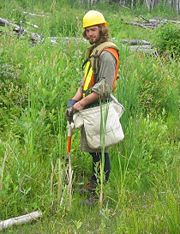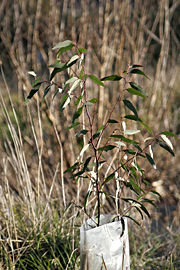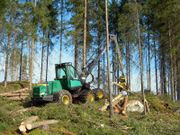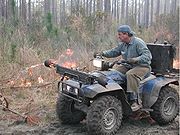Forestry
Forest ecosystems have come to be seen as one of the most important components of the biosphere, and forestry has emerged as a vital field of science, applied art, and technology.
Contents
» Activities» History
» Today
» Education
» References
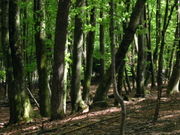
A deciduous beech forest in Slovenia.
Activities
Foresters may be employed by the Forestry Commission (in Britain) industry, government agencies, conservation groups, local authorities, urban parks boards, citizens' associations, or private landowners. Industrial foresters are predominantly involved in planning the forest regeneration process that starts with careful harvesting. Other foresters have specific jobs which include a broad array of responsibilities. For example, urban foresters work within town and city environments to manage teh trees in urban greenspace. Some foresters work in tree nurseries growing seedlings for woodland creation or regeneration projects. Others are involved with tree genetics or developing new building systems as forest engineers. The profession has expanded to include a wide diversity of jobs, typically requiring an honours degree or college bachelor's degree up to the PhD level for highly specialised areas of work.In Britain, the Public Forest Estate cared for by the Forestry Commission, is also managed for social objectives, including public access and recreation (including the very popular forest concert venues), habitat conservation, biodiversity.
Traditional forest management plans are chiefly aimed at providing logs as raw material for timber, veneer, plywood, paper, wood fuel or other industries. Hence, considerations of product quality and quantity, employment, and profit have been of central, though not always exclusive, importance.
While other duties of foresters may include preventing and combatting insect infestation, disease, forest and grassland fires, there is an increasing movement towards allowing these natural aspects of forest ecosystems to run their course, where possible, usually excepting epidemics or risk of life or property. Foresters are specialists in measuring and modelling the growth of forests (forest mensuration). Increasingly, foresters may be involved in wildlife conservation planning and watershed protection.
History
The use and management of forest resources has a long history in China, dating from the Han Dynasty and taking place under the landowning gentry. It was also later written of by the Ming Dynasty Chinese scholar Xu Guangqi (1562-1633). In the Western world, formal forestry practices developed during the Middle Ages, when land was largely under the control of kings and barons. Control of the land included hunting rights, and though peasants in many places were permitted to gather firewood and building timber and to graze animals, hunting rights were retained by the members of the nobility. Systematic management of forests for a sustainable yield of timber is said to have begun in the 16th century in both the German states and Japan. Typically, a forest was divided into specific sections and mapped; the harvest of timber was planned with an eye to regeneration.The practice of establishing tree plantations was promoted by John Evelyn; it had already acquired some popularity in the British Isles. Schools of forestry were established after 1825; most of these schools were in Germany and France. During the nineteenth and early twentieth centuries, forest preservation programs were established in the United States, Europe, and British India. Many foresters were either from continental Europe (like Sir Dietrich Brandis), or educated there (like Gifford Pinchot).
The enactment and evolution of forestry laws and binding regulations occurred in most Western nations in the 20th century in response to growing conservation concerns and the increasing technological capacity of logging companies.
Tropical forestry is a separate branch of forestry which deals mainly with equatorial forests that yield woods such as teak and mahogany. Sir Dietrich Brandis is considered the father of tropical forestry.
Today
Today a strong body of research exists regarding the management of forest ecosystems and genetic improvement of tree species and varieties. Forestry also includes the development of better methods for the planting, protecting, thinning, controlled burning, felling, extracting, and processing of timber. One of the applications of modern forestry is reforestation, in which trees are planted and tended in a given area.In many regions the forest industry is of major ecological, economic, and social importance. Third-party certification systems that provide independent verification of sound forest stewardship and sustainable forestry have become commonplace in many areas since the 1990s.
These certification systems were developed as a response to criticism of some forestry practices, particularly deforestation in less developed regions along with concerns over resource management in the developed world. Some certification systems are criticised for primarily acting as marketing tools and lacking in their claimed independence.
In topographically severe forested terrain, proper forestry is important for the prevention or minimization of serious soil erosion or even landslides. In areas with a high potential for landslides, forests can stabilize soils and prevent property damage or loss, human injury, or loss of life.
Education
The first dedicated forestry school was established by Georg Hartig at Dillenburg in Germany in 1787, though forestry had been taught much earlier in central Europe. The first in North America, the Biltmore Forest School was established near Asheville, North Carolina, by Carl A. Schenck in 1898 on the grounds of George W. Vanderbilt's Biltmore Estate. Another early school was the New York State College of Forestry at Cornell also established in 1898. Early North American foresters went to Germany from the nineteenth century to study forestry. Some early German foresters also emigrated to North America.In South America the first two forestry schools were established in Brazil, specifically in Viçosa, Minas Gerais, and in Curitiba, Paraná.
Today, an acceptably trained forester must be educated in general biology, botany, genetics, soil science, climatology, hydrology, economics and forest management. Education in the basics of sociology and political science is often considered an advantage.
An interesting scope of work opens up for foresters interested in international politics. Organizations such as the Forest Policy Education Network (FPEN)are dedicated to facilitate the way into forest politics and to exchange information on the subject.
In India, forestry education is imparted in the agricultural universities and in Forest Research Institutes (deemed universities). Four year degree programmes are conducted in these universities at the undergraduate level. Masters and Doctorate degrees are also available in these universities
Tropic Ventures Rainforest Enrichment and Sustainable Forestry Project is registered under the Auxiliary Forest Program of Puerto Rico, and is a demonstration project for students and foresters interested in the sustainable management and preservation of tropical rainforest land.
In the United States of America, postsecondary forestry education leading to a Bachelor's degree or Master's degree is accredited by the Society of American Foresters.
References
- Society of American Foresters (2008-05-19) (PDF). SAF Accredited and Candidate Forestry Degree Programs. Press release. http://www.safnet.org/education/forestry_degree_programs.pdf. "The Society of American Foresters grants accreditation only to specific educational curricula that lead to a first professional degree in forestry at the bachelor's or master's level."- Charles H. Stoddard Essentials of Forestry. New York: Ronald Press, 1978.
- Chris Maser. Sustainable Forestry: Philosophy, Science, and Economics. DelRay Beach: St. Lucie Press, 1994.
- Hammish Kimmins. Balancing Act: Environmental Issues in Forestry. Vancouver: University of British Columbia Press, 1992.
- Hart, C. 1994. Practical Forestry for the Agent and Surveyor. Stroud. Sutton Publishing.
- Herb Hammond. Seeing the Forest Among the Trees. Winlaw/Vancouver: Polestar Press, 1991.
- Hibberd, B.G. (Ed). 1991. Forestry Practice. Forestry Commission Handbook 6. London.
- "Forestry" in the Encyclopaedia Brtitannica 16th edition. New York: E.B., 1990.
